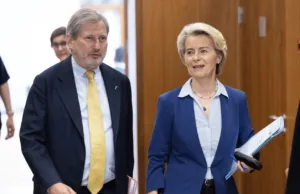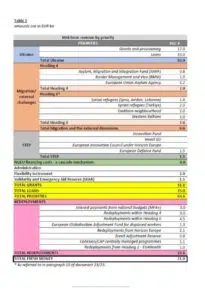Brussels – Following the revision of the Multiannual Financial Framework 2021-2027 with fresh new resources, the European Commission arrives with a proposal to amend the EU Budget 2024 with an increase in funds of EUR 5.8 billion compared to the EUR 189 billion original draft. “This amended EU budget will enable the Union to continue to deliver on common priorities this year, for the benefit of European citizens and beyond,” the EU executive stresses in a note, presenting the proposed amendment today (Feb. 29).

According to the commission’s proposal, all pillars of the multi-year EU budget agreed upon by the co-legislators after the decisive green light at the Feb. 1 European Council will be strengthened: “It will strengthen our support for Ukraine, increase investment in critical technologies and defence, and provide additional resources to support partners in the Western Balkans.” In addition, through this amendment, the EU budget “will be better equipped to help member states affected by natural disasters and countries facing humanitarian crises.” More specifically, the Ukraine Facility and the mobilization of the Ukrainian reserve will receive €4.8 billion more, the European Defense Fund (under the STEP platform) €376 million, the European Solidarity and Emergency Aid Reserves €365 million, and the Western Balkans Reform and Growth Facility, once the co-legislators approve it, an additional €501 million. Finally, provision is made for a change in the reserve for the European Globalization Adjustment Fund for displaced workers “to the actual needs of recent years.”
The EU Budget Review 2021-2027
The Commission proposal of June 2023 envisioned €65.8 billion in new contributions from member states (i.e., fresh resources to the EU budget) out of €98.8 billion overall, while the compromise reached on Feb. 1, 2024, sets a total of €64.6 billion, of which only €21 billion are new funds (another 10.6 are reallocations from already allocated programs). That is, less common spending capacity for the twenty-seven countries, with also heavy cuts on two of the review’s three pillars: migration and external dimension and especially critical technologies for the Union’s industrial competitiveness. The third pillar—that of Ukraine—has not been touched at all, which is still composed of €50 billion in total: €17 billion in grants (directly from additional or reallocated resources in the EU budget) and €33 billion in loans financed through borrowing on financial markets.
 As envisaged in the negotiating proposal of the President of the European Council, Charles Michel—already presented at the December 2023 summit and untouched by a penny—allocations for the chapter Migration and External Dimension (from €12.5) were raised to €9.6 billion, with €2 billion remaining unchanged under heading 4 Migration and Border Management for the implementation of the Migration and Asylum Pact: €0.8 billion for the Asylum Migration and Integration Fund (AMIF), €1 billion for the Border and Visa Control Instrument (BMVI), and €0.2 for the EU Asylum Agency (EUAA). The remaining €7.6 billion in this pillar relates to Heading 6 External Challenges, with cuts to support Syrian refugees in Turkey (from €3.5 to 2) and Syria, Lebanon and Jordan (from €1.7 to 1.6), the disappearance of the €3 billion for the NDICI financial instrument for external action, the €2 billion originally planned for the Western Balkans, and an increase in funds to the Southern Neighborhood (from €0.3 to 2) to intervene in these migration routes.
As envisaged in the negotiating proposal of the President of the European Council, Charles Michel—already presented at the December 2023 summit and untouched by a penny—allocations for the chapter Migration and External Dimension (from €12.5) were raised to €9.6 billion, with €2 billion remaining unchanged under heading 4 Migration and Border Management for the implementation of the Migration and Asylum Pact: €0.8 billion for the Asylum Migration and Integration Fund (AMIF), €1 billion for the Border and Visa Control Instrument (BMVI), and €0.2 for the EU Asylum Agency (EUAA). The remaining €7.6 billion in this pillar relates to Heading 6 External Challenges, with cuts to support Syrian refugees in Turkey (from €3.5 to 2) and Syria, Lebanon and Jordan (from €1.7 to 1.6), the disappearance of the €3 billion for the NDICI financial instrument for external action, the €2 billion originally planned for the Western Balkans, and an increase in funds to the Southern Neighborhood (from €0.3 to 2) to intervene in these migration routes.
But what comes out sharply scaled back from the commission’s proposal is the financial support for the STEP chapter, the platform for critical technologies in deep tech, clean tech, and biotech, to push the Union’s industrial competitiveness in response to the US Inflation Reduction Act and China. With the understanding of the co-legislators, only 1.5 billion euros are left—and only for defence—crumbs compared to the original idea of the EU Commission: €10 billion to be allocated to increasing the budgets of the InvestEu (3), Horizon Europe (0.5), Innovation Fund (5) and European Defense Fund (1.5, the only surviving funds) programs. On the climate and environment side, it is also worth noting the €1 billion cut (from 2.5 to 1.5) to the Solidarity and Emergency Reserve (SEAR) for humanitarian and natural crisis response capacity over the next four years.
Also of note are the technical adjustments. The Commission’s proposal to increase national contributions by 23.8 billion was almost entirely rejected. Only the Flexibility Instrument (reduced from €3 billion to 2 billion) survived, i.e., the top-up of EU budget margins to respond to unforeseen needs, while the €1.9 billion in administrative costs and especially the €8.9 billion for the new special European Union Recovery Instrument (EURI), whose sole purpose is to cover the additional costs associated with Next Generation Eu loans, were derecognized. The instrument has been created, but there are no funds—and in case of need, it will be used in a three-step procedure. A final mention deserve the cuts to existing programs to derive the €10.6 billion in resignations according to the EU budget review: €2.1 billion from Horizon Europe, one from the Health Union, and 1.1 from the centrally managed programs of the Cohesion Policy and Common Agricultural Policy (CAP) are particularly affected, on which came criticisms from the president of the European Parliament, Roberta Metsola: “The agreement takes funds away from the programs our citizens depend on, from some of the most tangible benefits of the EU.”
English version by the Translation Service of Withub



![[foto: imagoeconomica]](https://www.eunews.it/wp-content/uploads/2023/09/Imagoeconomica_1917240-scaled.jpg.webp)